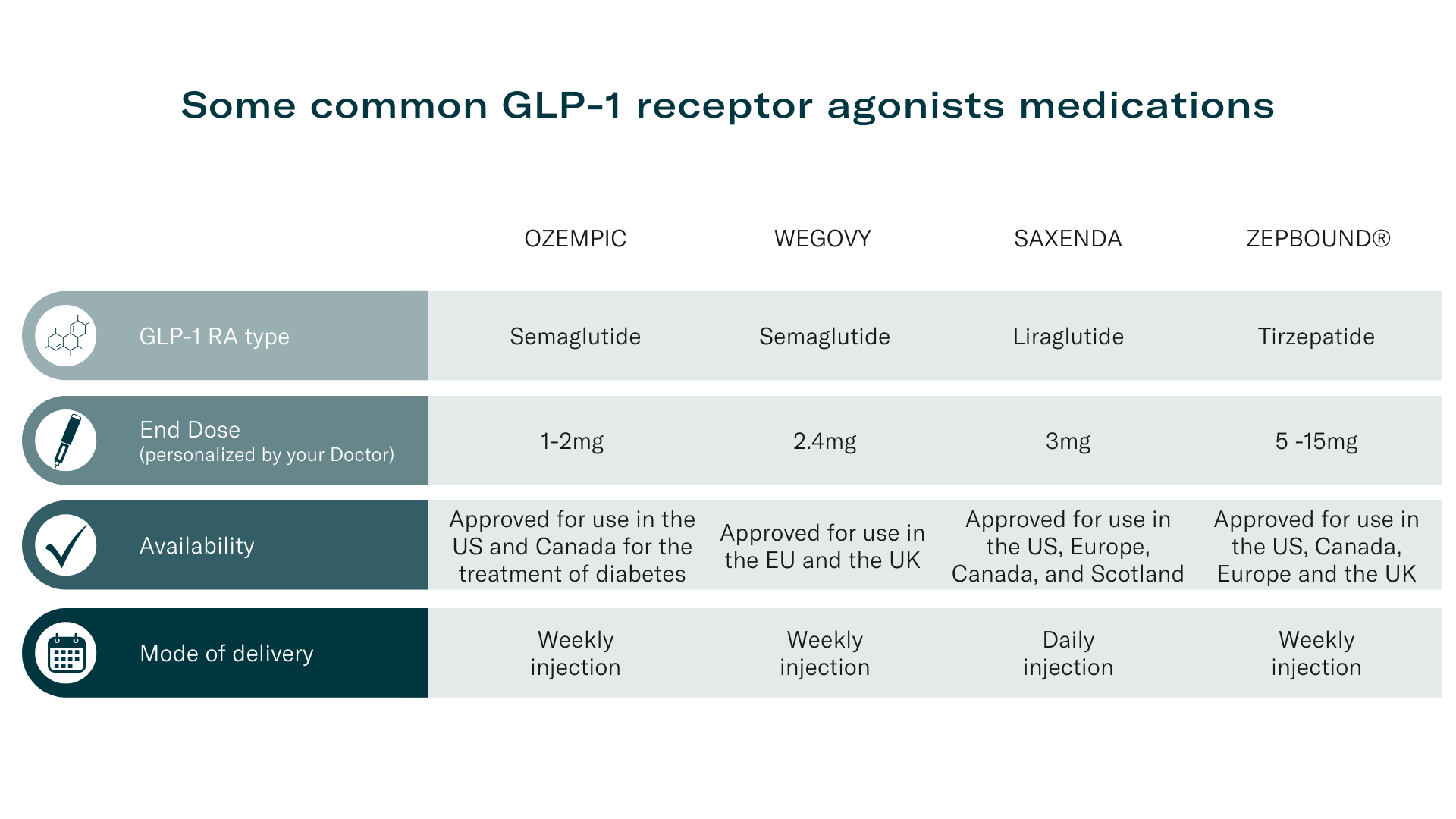Allurion Programme vs Weight-Loss Medications for Sustainable Weight Loss

When you look in the media these days, it seems like there are new weight-loss treatments being approved all the time – sometimes it can be hard deciding which one is right for you on your own.
In addition to gastric balloons and weight-loss surgery, there are also a range of weight-loss drugs (also known as Anti-Obesity Medications) now available – some of them touted as miracle treatments for obesity. In recent months, injectable drugs that impact appetite and lead to weight loss such as Ozempic and Wegovy, have received significant coverage in both traditional media and on social media.
Before choosing a treatment, it’s important to know what each treatment has been proven to do, its safety record, the support you’ll have access to and how it might fit into your own goals, lifestyle and weight-loss plans. Before starting any treatment, it is vital to discuss with your qualified healthcare team who can guide you to the right treatment for you.
In this article, we’ll present an overview of some of the common anti-obesity medications including information on how they work, their side effects and weight-loss results, and how they match up to the Allurion Programme in terms of sustainable weight loss.
How do GLP-1 weight-loss medications like semaglutide work?
Anti-Obesity medications like Saxenda® and Wegovy® belong to a class of medications known as GLP-1 receptor agonists and have been gaining popularity as a weight-loss solution.
What are GLP-1 receptor agonists (GLP-1 RAs)?
GLP-1 RAs are a class of medications that have traditionally been used to manage diabetes but are now also used to help with weight loss. They work by mimicking a naturally occurring hormone in the body called GLP-1 (glucagon-like peptide-1), a hormone that is released in the gut and brain when you eat1-4 and has many complex metabolic roles including; regulation of insulin (a hormone that decreases your blood sugar levels), control on sugar production in your liver and delaying gastric emptying.
Wegovy® contains the GLP-1 RA semaglutide and Saxenda® contains the GLP-1 RA liraglutide. There are also newer medications like Zepbound® which contains Tirzepatide. The medications approved for use for the treatment of diabetes are similar in terms of the active ingredient like Mounjaro® (Tirzepatide) and Ozempic® (semaglutide), but this is given in a lower dose.
In simple terms, GLP-1 RAs help to make you feel fuller after smaller meals and feel fuller for longer, reducing your appetite, meaning you are more likely to eat less food overall.1-4
Together with lifestyle changes such as eating a healthier balanced diet and being more active, GLP-1 RAs help support weight loss. Some people also experience an impact on physical feelings of hunger and an impact on eating habits associated with reward (for example reduced pleasure in eating high-fat or sugary foods).
For these medications to have the biggest impact on your health and body weight, they should be combined with lifestyle changes like exercise, stress reduction, adequate sleep, and a nutrient-rich diet.
It is now understood that obesity is a chronic disease, with complex biological and environmental aspects at play. GLP-1 RAs can be extremely helpful for someone whose biology is not functioning correctly due to the disease of obesity, and whose biology makes weight loss and maintaining the weight loss more challenging.

We put together this table to help you understand some common options in the market:

How does the Allurion Programme work?
The Allurion Programme combines the Allurion Gastric Balloon, expert medical guidance, personalised nutrition coaching and a powerful suite of digital tools to deliver fast, healthy and sustainable weight loss. The Allurion Balloon helps you feel fuller on smaller portions and fuller for longer so you are likely to eat less, while the comprehensive 6-18 month behavioural change programme helps you readjust your mindset towards food and adopt healthier habits – check your eligibility here.
Unlike the weight-loss medications mentioned above which require daily or weekly injections, the Allurion Balloon is a non-surgical weight-loss tool. The simplicity of the Allurion Balloon also means it has no systemic effect on the body, and is less invasive than weight-loss medications. After being placed in the stomach for approximately 4 months, it self-deflates and passes out of the body naturally through the gastrointestinal tract.

Both the Allurion Programme and weight-loss medications aim work in similar ways; helping to make you feel fuller faster and for longer. They both work on managing your physical hunger. The Allurion Balloon serves as a tool to enhance your awareness of your body's signals, which can have lasting effects, helping you develop a deeper understanding of hunger and fullness cues that extends beyond the treatment period.
However, there some key differences in the weight loss impacts between the 2 treatments; not only in terms of the treatment itself, but the speed as well.
How much weight can you lose with GLP-1s (semaglutide) vs the Allurion Programme?
Now that we know how GLP-1s and the Allurion Programme work, let’s compare their effectiveness in terms of weight loss.
Studies are still being conducted to better understand the impact that GLP-1s like Wegovy (and other GLP-1-based drugs) have on weight loss. However, the importance of combining lifestyle change with the medications is clear.
In clinical studies showcasing the impact of GLP-1s on weight management, depending on the medication, dose and personal circumstances, results of 10-20% body weight loss after 12-18 months on the programme have been achieved. It's crucial to note that all these studies integrate both lifestyle changes and GLP-1s, emphasizing the necessity of a combined program to achieve such significant results.
One 2021 study6 looked at 2,000 adults who were living with overweight or obesity. It compared people taking semaglutide at the 2.4mg dose (Wegovy) in combination with lifestyle changes (diet and exercise programs) with people who only made lifestyle changes.
The study found that on average, people taking semaglutide lost 14.9% of their starting body weight after 68 weeks (almost 1 1/2 years). Those who tried lifestyle changes alone lost on average 2.4% total body weight.
Other studies have shown similar initial results for Wegovy, but it must be noted that studies have also demonstrated that people who take semaglutide tend to put weight back on when they stop taking it, with two-thirds of their prior weight loss regained at one year after stopping.7
In comparison, numerous studies have shown that patients on the Allurion Programme lose, on average, 10-15% of their body weight in approximately 4 months.8 A second balloon placement over a 12-month extended programme can deliver an average total body weight loss of 23%.9
In terms of weight loss, this suggests that the weight loss achieved with the Allurion Programme is much faster; supporting quicker impacts on health and wellbeing.
How fast can you see results? Allurion Programme vs GLP-1s
When we talk about the speed of seeing weight-loss results, research suggests that the Allurion Programme is superior to GLP-1s in bringing about fast weight loss.
In the first 30 days alone, the average Allurion patient already sees 7% body weight loss10 and achieves 10-15% weight loss in approximately 4 months.8
In comparison, the study above on semaglutide injections (Wegovy) shows that patients achieve 14.9% body weight loss after almost 1.5 years.6
In addition, the faster weight loss that our patients achieve with the Allurion Programme has significant benefits from a behavior change and health improvement perspective. In fact, the evidence shows that the type of supported rapid weight loss delivered by the Allurion Programme can be a more effective and healthy approach to weight management than a gradual weight-loss approach that is seen with GLP-1s.

How sustainable is weight loss from the Allurion Programme vs GLP-1s?
Successful weight loss is not just about shedding pounds temporarily; it's about maintaining results over the long term and steering clear of the frustrating cycle of weight regain.
The Allurion Programme has been proven to deliver sustainable weight loss; in fact, studies show that 96% of the weight lost with the Allurion Programme is sustained, on average, at 1 year after the balloon passes.10

This is largely credited to the medical support (both in-person and digital), and nutrition and behaviour coaching that are key elements of the programme. The Allurion Balloon serves as the catalyst for the initial weight loss, and patients are then given the knowledge and support during the programme to make lasting behavioural changes that help them continue the weight loss.
In comparison, when looking at GLP-1s, research suggests that people tend to put the weight back when they stop taking their medications, with just 39% of the weight lost sustained at one year after medical treatment has been stopped.7
In fact, a recent survey (Dec 2023) from Deutsche Bank on 600 consumers in the US revealed that the caloric intake of patients tended to increase after they stop using GLP-1 medications like Ozempic or Wegovy, and, in certain instances, even surpassed the pre-treatment consumption levels.
This could be partly due to individuals on GLP-1 medications getting support during their treatment period but not addressing underlying issues that led to weight gain in the first place. When you want to sustain weight loss, how you lose the weight matters and behaviour change must occur.
This is why the Allurion Programme places great importance on readjusting your mindset towards food, behaviour change and building better habits for long-term weight management.
How invasive is it? The Allurion Balloon vs GLP-1s
When we compare weight-loss methods, many individuals gravitate towards the least invasive approach.
For some patients taking an injectable medication this isn’t a challenge, but for many this is not something they are comfortable with. We know that interest among patients for GLP-1s is high, especially in people trying to lose weight, but injection delivery is one of the key barriers. Patients tell us that their main reasons for choosing the Allurion Program instead of a medication are the non invasive nature of no injections. In fact, recent surveys demonstrate that around a third of people would simply not want to take an GLP-1 because they don’t want to take a medication.13

In the case of GLP-1 medications, patients need to do daily or weekly injections of GLP-1 receptor agonists like semaglutide, which mimic the naturally occurring GLP hormone in our bodies. These drugs are designed to alter your physiology, which may have health implications.
In contrast, the Allurion Gastric Balloon does not have any systemic impact because it is never absorbed into the body. It’s filled with water and takes up space in the stomach for a period of time, helping you feel full while you learn to eat differently.

The space taken up by the balloon means that nerves in your stomach are stretched quickly, telling your brain you have eaten more food, thus helping you feel fuller quicker.
The Allurion Gastric Balloon, in this regard, is much less invasive compared to to Anti-obesity medications.
Can you combine GLP-1s with the Allurion Programme?
The short answer is, yes you can. Most of our patients achieve their weight-loss goals with the Allurion Programme alone, but they may consider the addition of Anti-Obesity medications during or after the programme, if advised by their doctor.
A recent survey of 172 healthcare professionals showed that almost 90% of them believed that the Allurion Programme represented an ideal first-line treatment to achieve at least 10% total body weight loss in a fast and sustainable way.
However, research has also shown promising weight loss results when therapies are combined. In a recent study, 92% of patients achieved their goals on the Programme alone. For those who went on to combine the Allurion Programme with the GLP-1 Saxenda® (liraglutide), they achieved an average total body weight loss of nearly 19% after approximately 4 months of combined treatment.11
The findings from this study suggest that for certain patients, anti-obesity medications can be combined with the Allurion Programme to enahnce results.
Conclusion
The best weight management treatment is personal to you, dependent on factors like your goals, health and wellbeing and preferences, etc. There are a range of effective treatments out there, and increasingly people use multiple treatments in combination and succession. Many people find fast, significant and sustainable weight loss following the Allurion Programme, meaning for them it is an ideal first-line treatment and many would not consider taking a medication at all.
For some patients, during or after the Allurion Programme, they may consider the addition of Anti-obesity medications if advised by their expert clinic team. To find your best treatment option, speak with an Allurion advisor who will be able to direct you to a doctor in our partner clinics.
References
- European Medicines Agency. Ozempic. https://www.ema.europa.eu/en/documents/overview/ozempic-epar-summary-public_en.pdf. Accessed 13 July, 2023.
- European Medicines Agency. Wegovy (semaglutide). https://www.ema.europa.eu/en/documents/overview/wegovy-epar-medicine-overview_en.pdf. Accessed 13 July, 2023.
- Electronic Medicines Compendium (EMR). Wegovy 0.25 mg, FlexTouch solution for injection in pre-filled pen. UK Medicines and Healthcare Products Regulatory Agency https://www.medicines.org.uk/emc/product/13799/smpc#gref. Accessed 13 July, 2023.
- US Food and Drug Administration. FDA Approves New Drug Treatment for Chronic Weight Management, First Since 2014. https://www.fda.gov/news-events/press-announcements/fda-approves-new-drug-treatment-chronic-weight-management-first-2014. June 4, 2021.
- https://www.nice.org.uk/guidance/ta875/resources/semaglutide-for-managing-overweight-and-obesity-pdf-82613674831813
- Wilding JPH, Batterham RL, Calanna S, et al. Once-Weekly Semaglutide in Adults with Overweight or Obesity. N Engl J Med. 2021;384(11):989-1002. doi:10.1056/NEJMoa2032183
- Wilding JPH, Batterham RL, Davies M, et al. Weight regain and cardiometabolic effects after withdrawal of semaglutide: The STEP 1 trial extension. Diabetes Obes Metab. 2022;24(8):1553-1564. doi:10.1111/dom.14725
- Ienca, R et al. Obesity surgery vol. 30,9 (2020): 3354-3362, The Procedureless Elipse Gastric Balloon Program: Multicenter Experience in 1770 Consecutive Patients
- Ienca et al. Sequential Allurion Balloon Treatment 1- Year Weight Loss Results Approximate Bariatric Surgery Results, TOS Obesity Week, 2020.
- Ienca R, Oyola C, Jarallah M, et al. The Swallowable Gastric Balloon Program: Global experience in 3,716 patients. (2022), Oral Abstracts. Obesity, 30: 4-54. https://doi.org/10.1002/oby.23625
- Ienca R, Ayuso L, Shahin M. Swallowable intragastric balloon program and GLP1 agonist combined treatment for obesity: an international multicenter study. Presented at ECO 2023.
- Bhandari M, Mathur W, Kosta S, Reddy M. Combination therapy of GLP-1 analogues with swallowable balloon for treatment of obesity. Presented at IFSO 2023.
- Poll: KFF Health Tracking Poll July 2023: The Public’s Views Of New Prescription Weight Loss Drugs And Prescription Drug Costs | KFF



